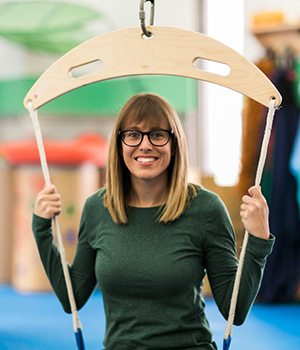Looking for a way to work on fine motor skills with your child that does NOT involve handwriting? Here are 11 “non handwriting” fine motor activities you can set up for your child at home.
- Theraputty creations – Use Theraputty or Play-Doh to create various figures (e.g. animals, people, food, etc.). Encourage your child to use small pegs, beads, pennies, or buttons to add details to their creation and for extra in-hand manipulation use!
- Hammer and pegs – All you need is a toy or wooden hammer, golf tees, and foam cooler! Hammering is an excellent way for your child to develop handedness, strengthen muscles, and practice force calibration. Your child can use tees to hammer different designs, letters, or numbers. You can cut out and hammer pictures into the cooler, too!
- Spray bottle – This tool can provide endless fun for your child, while also working to develop muscles and separation of the two sides of the hand for development of fine motor skills, such as, holding a writing utensil or cutting. Use the spray bottle in the bathtub, when playing outside with sidewalk chalk and foam soap, or when painting.
- Wikki Sticks – Use this fun tool to create just about anything! These small sticks bend, fold, and mold. Children can warm up and strengthen their finger muscles by manipulating, pushing, and pressing them into shapes, letters, and numbers. You can find them here – https://www.wikkistix.com/
- Clothespins – Use these throughout the home to encourage your child to further develop grasping skills. You can hang up puzzle pieces for the child to gather one by one. They can also be used to hang up pictures and art work.
- Stencils and Templates – These tools are excellent ways to work on bilateral hand skills. Tape a stencil or template to paper and encourage your child to use their non-dominant hand to hold the stencil in place, while the child traces the stencil or colors over the template.
- Stickers – Peeling stickers is a simple way to focus on developing muscles of the skilled side of the hand. Encourage your child to start a sticker collection and incorporate stickers when working on coloring or drawing activities.
- Zoo Sticks – This is one of our favorite tools! Zoo Sticks are fun grabbers that can be used when eating snack or easily included to manipulate board game pieces. Grabbers are great tools to work on strengthening the skilled side of the hand and opening the web space of the hand. Zoo Sticks are available for purchase at Emerge, or can be found here: https://www.therapyshoppe.com/category/P1899-zoo-sticks-fish-farm-sticks-fine-motor-tools-kids-tongs
- Tissue and Paper Tear – Use newspaper or tissue paper to tear and crumble. Use the paper pieces to glue and create pictures or designs. This activity is ideal for finger strengthening and also to develop the palmar arches of the hand.
- Tug of War – Do you have a rope or towel at home? Use these objects and select a safe space to play! This fun and simple game gives the hands intrinsic muscle development, which is important for manual control and in-hand manipulation skills.
- Card games – It is easy to forget the benefits of card games. “Go Fish”, “Old Maid”, and “Uno” are quick games to pick up. Encouraging your child to sort, hold, and deal cards also works to increase intrinsic muscles of the hand.
If you have further questions regarding these activities, please consult with your child’s occupational therapist.
11 Fine Motor Activities to Try at Home

